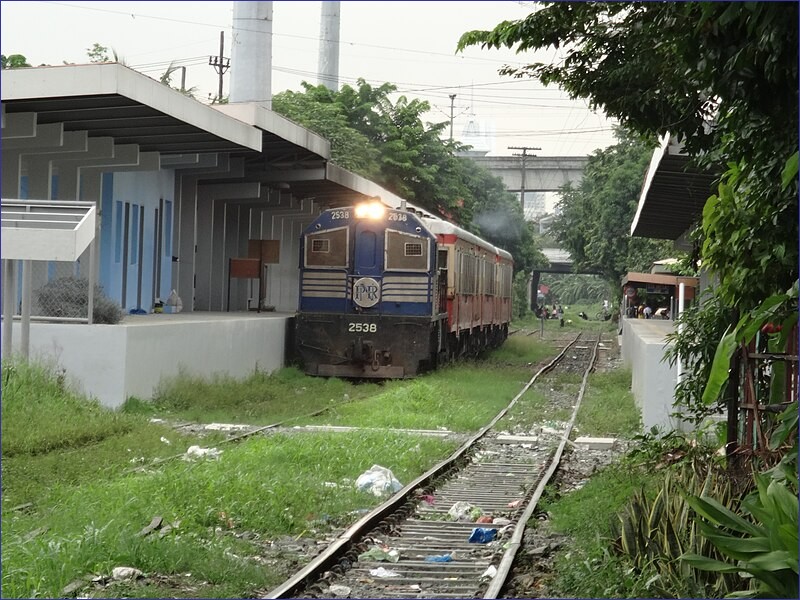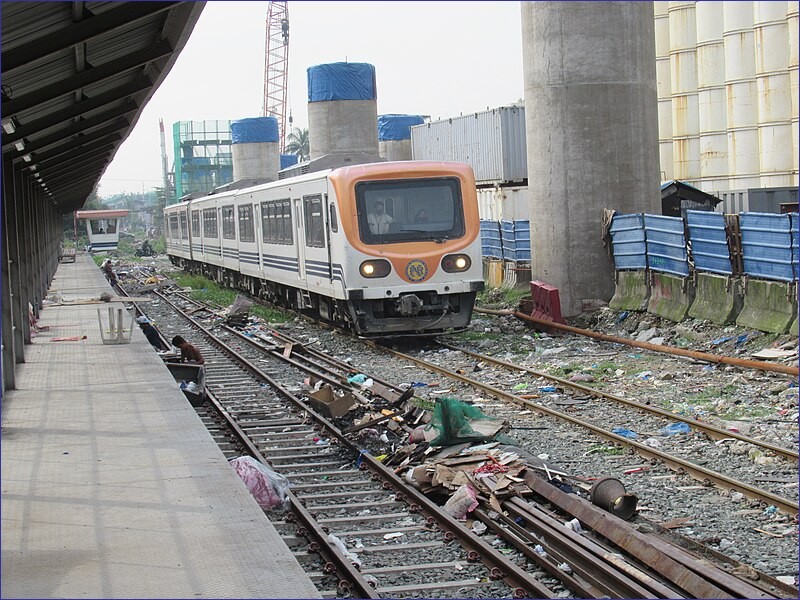Train travel in the Philippines is currently possible only on Luzon Island. In the past, passenger trains also operated on Panay and Cebu islands. The country has a railway network measuring 539 km in total, of which approximately 275 km are used for passenger and freight transport. The only railway operator in the country is Philippine National Railways (PNR). Currently, passenger trains only run on commuter lines in Manila, along with a regional train operating in the Bicol region. In the coming years, new railway lines are planned for Manila to help relieve road traffic congestion. There are also plans to build 830–1500 km of railways on Mindanao Island and to rebuild the railway lines on Panay Island.
Last updated: 01.07.2025
Table of contents:
1. Current situation
2. Sugar railways on the Negros Island
3. Railway on Panay Island
4. Railway on Cebu Island
5. Bicol Express

1. Current Situation
The state-owned Philippine National Railways provides passenger services on two light rail transit (LRT) lines and one metro rail transit (MRT) line in Manila. Additionally, a regional line operates in the Bicol region. There are no long-distance trains, although a major modernization of the railway line toward the southern part of Luzon Island is planned.
It’s important to note that the railway infrastructure in the Philippines is vulnerable to natural disasters such as monsoons, typhoons, floods, and landslides, which have often damaged the tracks in the past, leading to service interruptions that sometimes lasted for several years.
Currently, Philippine National Railways operates regional trains on the Naga – Sipocot and Naga – Legazpi routes.
In Manila, PNR operates a commuter rail line from Tutuban Station to Calamba Station, located 56 kilometers away. Only one train per day reaches Calamba, while most trains terminate at Sucat Station, which is 25 kilometers from Tutuban.
The services are operated using a variety of rolling stock, including:
– Hyundai ROTEM commuter trains,
– diesel locomotives with Japanese 203-series electric multiple units,
– diesel multiple units KiHa 350 and KiHa 52.
Useful websites:
Philippine National Railways – official website
Philippine National Railways – official profile with timetable (Facebook)

2. Sugar Railways on the Island of Negros
Several sugar railways operated or operate on Negros Island. The most well-known is the sugar railway at the Bais sugar mill. According to a 2007 FarRail tour itinerary, around 90 km of sugar railway lines were still active around the city at the time, operated by 30 Plymouth-type diesel locomotives. One of the local attractions is a steam locomotive monument located in the city center.
Many tourists visit La Carlota, home to one of the largest and oldest sugar mills in Asia, owned by Central Azucarera de La Carlota. Until recently, sugar railways in the area were still operated by steam locomotives, but due to the high maintenance cost, these are now only used for special trips arranged for railway enthusiasts. On regular days, the steam locomotives can be seen at the mill’s locomotive depot.
A third operational sugar railway on Negros runs between Bacolod and Silay, on the grounds of a sugar mill managed by Hawaiian-Philippine. This line was known for its distinctive blue steam locomotives, which have since been replaced by diesel locomotives. The sugar railway network here is 22 kilometers long. The mill was established on June 3, 1918, by plantation owners who had come from Hawaii.
There is likely another sugar railway operating around Binalbagan, where five diesel locomotives are in use. Two steam locomotives, though no longer operational, can also be seen there.
3. Railway on Panay Island
Currently, no trains operate on Panay Island, but it’s worth mentioning the island’s railway history as it was once home to the longest railway line in the Philippines outside of Luzon, and it provided passenger service.
The railway was constructed in record time—on March 5, 1906, the construction plan was approved, work began in June, and by mid-1907, construction crews met in the middle of the line, completing the build. The Roxas–Iloilo line was put into operation immediately afterward. The total length was 117 kilometers, running north to south across Panay, dividing the island into western and eastern sections. There were 19 regular stations and 10 request stops along the route.
The line was operated by Philippine Railway Co. (PRC), but it was not profitable.
During World War II, parts of the line were destroyed but were quickly rebuilt.
For several decades afterward, the line handled both passenger and freight services, and in the 1970s, relatively modern passenger trains were introduced.
Between the late 1970s and early 1980s, a 12-kilometer branch line was built from Dueñas to Calinog to serve the Calinog sugar mill, though it was shut down after a few years.
Sources report different dates for the line’s closure. According to some, trains stopped running as early as 1983. Others state that passenger services ended in 1985, with freight services continuing until 1989.
For over a decade, there has been discussion of rebuilding the Roxas–Iloilo railway, as well as constructing a new line from Roxas to Kalibo and Caticlan, from which passengers could transfer to a ferry bound for the tourist island of Boracay. There are also plans for a monorail connecting Iloilo City to its airport.
4. Railway on Cebu Island
Panay was not the only island in the Philippines to have a fully functioning passenger and freight railway. A slightly shorter line was built on Cebu Island and opened in 1907.
The railway connected Cebu City with Danao (to the north) and Argao (to the south). The total length of the line was 96 kilometers. It was primarily used to transport coal, sugar, and other goods from the island’s interior to Cebu City.
The railway line was destroyed during World War II. It was not rebuilt, and very little remains of it today. For example:
The former Valladolid station is now a restaurant,
The Sibonga station serves as a primary school library,
The Argao station has been converted into a fire station.
There are often media reports about plans to build a commuter rail system in Cebu City, possibly a tram or monorail around 12 kilometers long. However, the old railway lines will not be rebuilt, and aside from a few low-quality photos, little evidence of them remains.
5. Train travel in Philippines – Bicol Express
The Bicol Express was the flagship train of the Philippine railway system. In its final years of service, it ran as a night train from Manila to Ligao (445 km). By Philippine standards, it offered a high level of comfort.
The train was composed of open-plain cars with 2+2 seating, Family sleeper cars and high standard Executive sleeper cars. All coaches were air-conditioned.
The Bicol Express made its debut on September 13, 1931. By 1938, after the railway line connecting the northern and southern parts of Luzon was completed, the train operated on a much longer route between Dagupan and Legazpi, compared to its 21st-century route.
The damage from World War II and natural disasters in the 1970s led to suspensions and route shortening.
In the following decades, a lack of investment and the gradual decline of the Philippine railway system took their toll—but the Bicol Express survived, mainly because it remained popular with tourists looking for a comfortable route to a scenic region.
In the 21st century, however, the train’s fate worsened due to natural disasters and accidents:
On November 12, 2004, a derailment killed 10 passengers and injured over 100.
In late September and November 2006, typhoons destroyed large sections of the line, and service was suspended.
It took five years to repair the tracks. On June 29, 2011, the train was restored on the Manila–Naga section, and on June 13, 2012, the route was extended to Ligao, about 30 kilometers from Legazpi.
Unfortunately, in 2012, the Bicol Express was suspended again indefinitely and has not operated since.
There are plans to rebuild the route, purchase new rolling stock, and reinstate the service. The line is expected to be rebuilt by Chinese contractors, and trains are planned to run at 80–100 km/h, with only 6 stops instead of the previous 32.
The line has significant tourist potential due to the beautiful landscapes, but trains would need to operate during daylight hours. At present, they cannot compete with the numerous buses and minibuses serving the region, which transport locals and tourists at very low cost.
Rebuilding the railway line is very expensive, and the frequent typhoons that hit the Philippines pose a major threat of landslides, which could again damage infrastructure and suspend train services for years.
Related articles:
